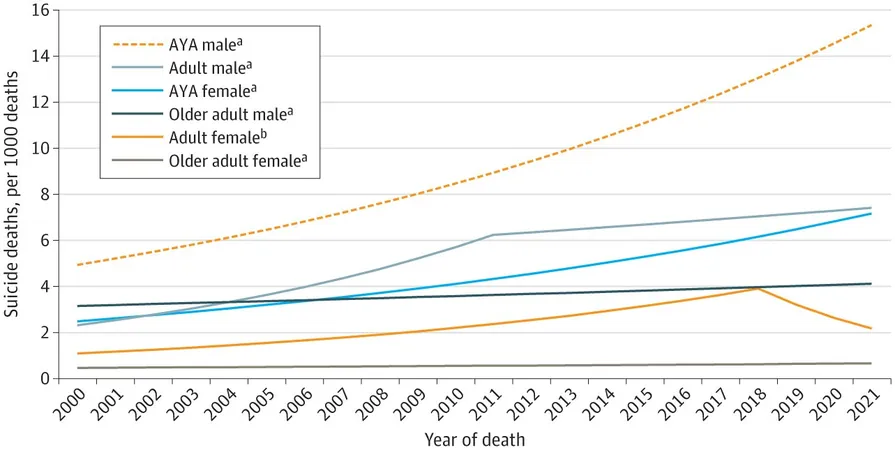
Alarming Surge: Young Male Cancer Survivors Face Tripled Suicide Rates in Recent Years
2024-11-18
Author: Yu
Introduction
New research from the USC Norris Comprehensive Cancer Center, recently published in JAMA Network Open, unveils a shocking reality: adolescent and young adult (AYA) male cancer survivors are experiencing an alarming spike in suicide rates, dramatically escalating over the past two decades.
Key Findings
The study reveals that from 2000 to 2021, the number of suicide fatalities within the male AYA cancer survivor group, aged 15-39, surged three-fold. By 2021, an alarming statistic emerged—one in every 65 deaths in this demographic was due to suicide. Although other cancer survivor groups also show rising suicide rates, the disparity between young men and other demographic groups has intensified, marking a troubling trend.
Emotional Burdens of Survivors
As cancer diagnoses among the youth continue to rise, it's crucial to acknowledge the heightened emotional burdens these survivors endure. According to findings from the American Cancer Society and the National Comprehensive Cancer Network, cancer survivors—particularly young males—are at a higher risk of facing mental health challenges like anxiety, depression, and suicidal ideation.
Research Methodology
This study is pioneering in closely analyzing suicide rates by gender specifically within AYA cancer patients. Researchers conducted an extensive analysis using data from the National Cancer Institute's Surveillance, Epidemiology, and End Results Program, encompassing nearly 4.5 million deaths among cancer survivors over the 21-year period.
Age and Gender Analysis
Dividing the data into three distinct age brackets—15-39, 40-59, and 60-plus—and further categorizing them by gender, the findings were startling. In 2000, only 4.9 deaths per 1,000 among male AYA cancer patients were attributed to suicide. Fast forward to 2021, and that figure soared to 15.4 per 1,000, starkly contrasting the suicide rates of other cancer patient groups, which remained significantly lower, between 0.6 and 7.4 per 1,000 accounted deaths.
Common Cancer Types
Particularly noteworthy was the identification of the three cancers most prevalent among male young adult survivors who took their own lives: thyroid cancer, testicular cancer, and melanoma. Disturbingly, these types of cancer boast some of the highest five-year survival rates, suggesting that surviving cancer does not equate to emotional wellness.
Urgent Call for Support
Despite some limitations—for instance, researchers lacked detailed patient information concerning mental health status prior to cancer diagnosis and methods or motives behind suicide—the study's authors stress the urgency for increased awareness about the mental health needs of AYA cancer survivors, particularly males. They advocate for comprehensive long-term support systems and resources aimed at this vulnerable group, emphasizing that a proactive approach could potentially reverse this devastating trend.
Conclusion
With the psychological well-being of cancer survivors remaining an urgent public health concern, this study calls on healthcare providers, caregivers, and society at large to pay closer attention. Could addressing mental health needs be the key to saving lives? The evidence suggests we must act now to protect our young warriors battling cancer.


 Brasil (PT)
Brasil (PT)
 Canada (EN)
Canada (EN)
 Chile (ES)
Chile (ES)
 España (ES)
España (ES)
 France (FR)
France (FR)
 Hong Kong (EN)
Hong Kong (EN)
 Italia (IT)
Italia (IT)
 日本 (JA)
日本 (JA)
 Magyarország (HU)
Magyarország (HU)
 Norge (NO)
Norge (NO)
 Polska (PL)
Polska (PL)
 Schweiz (DE)
Schweiz (DE)
 Singapore (EN)
Singapore (EN)
 Sverige (SV)
Sverige (SV)
 Suomi (FI)
Suomi (FI)
 Türkiye (TR)
Türkiye (TR)